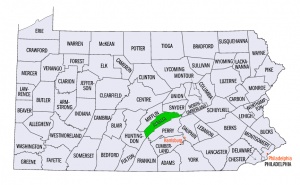Difference between revisions of "Juniata County (Pennsylvania, USA)"
GameoAdmin (talk | contribs) (CSV import - 20130816) |
GameoAdmin (talk | contribs) (CSV import - 20130823) |
||
| (One intermediate revision by the same user not shown) | |||
| Line 1: | Line 1: | ||
| − | + | [[File:PA_Juniata.jpg|300px|thumb|right|''Juniata County, Pennsylvania | |
| − | |||
| − | |||
| − | |||
| − | |||
| − | |||
| + | U.S. Census TIGER/Line map '']] Juniata, a county in central [[Pennsylvania (USA)|Pennsylvania]] had four Mennonite congregations in the 1950s -- two [[Mennonite Church (MC)|Mennonite Church]] congregations, one [[General Conference Mennonite Church (GCM)|General Conference Mennonite Church]] congregation and one [[Old Order Amish|Old Order Amish]]. Among the Mennonite settlers to locate here in 1774 were the [[Krehbiel (Krehbill, Krebell, Kraybill, Krayenbuhl, Crayenbühl, Craybill, Grabill, Graybill) family|Krehbiels ]] from central Europe by way of Lancaster and Franconia districts. One of the Mennonite Church congregations worshiped alternately at Cross Roads and [[Lauver Mennonite Church (Richfield, Pennsylvania, USA)|Lauver]], the other at Lost Creek and Delaware. These two congregations had 300 members. Nearby Susquehanna and Locust Grove (a mission) in Snyder County and [[Buffalo Mennonite Church (Lewisburg, Pennsylvania, USA)|Buffalo]] in Union County were part of the same settlement. These Mennonite Church congregations were affiliated with the [[Lancaster Mennonite Conference (Mennonite Church USA)|Lancaster Mennonite Conference]]. The General Conference Mennonite Church congregation at Richfield was organized in 1884; its membership was 312. A few Amish families came to the county as early as 1760, and there were three congregations in the 19th century, but they all moved away by 1890. Amish families from [[Mifflin County (Pennsylvania, USA)|Mifflin County]] and from adjoining states again moved into the county in 1950, establishing one congregation. Juniata County is the birthplace of several noted leaders; [[Kauffman, Daniel (1865-1944)|Daniel Kauffman]] (1865-1944) was born here. | ||
{{GAMEO_footer|hp=Vol. 3, p. 128|date=1957|a1_last=Hostetler|a1_first=John A|a2_last= |a2_first= }} | {{GAMEO_footer|hp=Vol. 3, p. 128|date=1957|a1_last=Hostetler|a1_first=John A|a2_last= |a2_first= }} | ||
Revision as of 14:05, 23 August 2013
Juniata, a county in central Pennsylvania had four Mennonite congregations in the 1950s -- two Mennonite Church congregations, one General Conference Mennonite Church congregation and one Old Order Amish. Among the Mennonite settlers to locate here in 1774 were the Krehbiels from central Europe by way of Lancaster and Franconia districts. One of the Mennonite Church congregations worshiped alternately at Cross Roads and Lauver, the other at Lost Creek and Delaware. These two congregations had 300 members. Nearby Susquehanna and Locust Grove (a mission) in Snyder County and Buffalo in Union County were part of the same settlement. These Mennonite Church congregations were affiliated with the Lancaster Mennonite Conference. The General Conference Mennonite Church congregation at Richfield was organized in 1884; its membership was 312. A few Amish families came to the county as early as 1760, and there were three congregations in the 19th century, but they all moved away by 1890. Amish families from Mifflin County and from adjoining states again moved into the county in 1950, establishing one congregation. Juniata County is the birthplace of several noted leaders; Daniel Kauffman (1865-1944) was born here.
| Author(s) | John A Hostetler |
|---|---|
| Date Published | 1957 |
Cite This Article
MLA style
Hostetler, John A. "Juniata County (Pennsylvania, USA)." Global Anabaptist Mennonite Encyclopedia Online. 1957. Web. 18 Apr 2024. https://gameo.org/index.php?title=Juniata_County_(Pennsylvania,_USA)&oldid=92189.
APA style
Hostetler, John A. (1957). Juniata County (Pennsylvania, USA). Global Anabaptist Mennonite Encyclopedia Online. Retrieved 18 April 2024, from https://gameo.org/index.php?title=Juniata_County_(Pennsylvania,_USA)&oldid=92189.
Adapted by permission of Herald Press, Harrisonburg, Virginia, from Mennonite Encyclopedia, Vol. 3, p. 128. All rights reserved.
©1996-2024 by the Global Anabaptist Mennonite Encyclopedia Online. All rights reserved.

